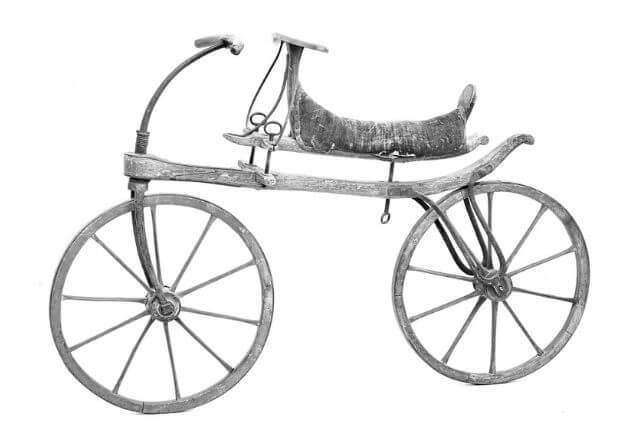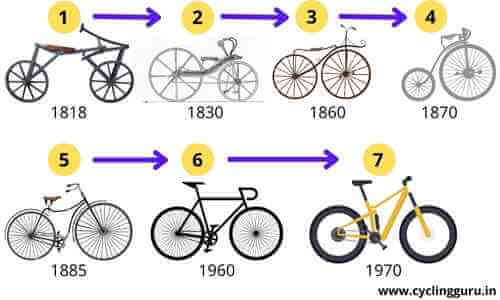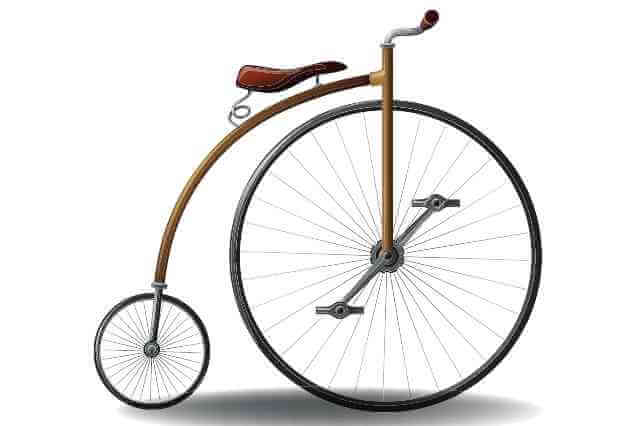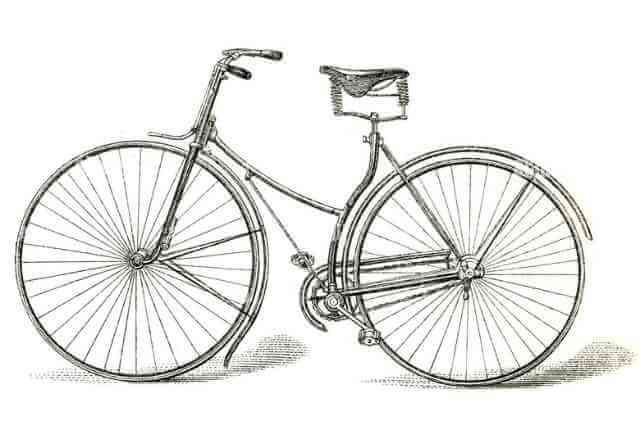A bicycle is a two-wheeled vehicle that is emphasised by a person riding it. Now, we enjoy riding bicycles. But, Have you ever thought about who invented the bicycle and when? The bicycle was first invented in the year 1817 by a German nobleman, Karl Freiherr von Drais. He designed the bicycle with a wooden frame and iron wheel, which was called the Draisienne and the dandy horse in Europe.
There were no pedals on the bicycle; that’s why the riders used to push the cycle with their feet. It was very challenging for the riders to ride a bicycle without pedals. That’s why Pierre Lallement invented the first pedalled bicycle in 1864.
Because the bicycle was designed with a front wheel, that’s why the size was limited so that it could go fast. Penny Farthing solved this problem in 1871 by creating the massive front-wheeled bicycle.
Guy’s this article is all about the science and history of the bicycle’s evolution. After reading this blog post all of your queries i.e., who invented the first bicycle, when was the bicycle invented, Who invented the bicycle with pedals etc will be solved.
Bicycles have a long history. Let’s look at it.
Who Brought the Concept of a Bicycle? The First Bicycle Sketch in 1493
The first man to come up with the concept of the bicycle was Leonardo da Vinci, but he was unable to design it. The news of the bicycle sketch was discovered in the 1970s during the restoration period of Codex Atlanticus.
In 1998, a professor of physics, Hans-Erhard Lessing, assured us that it was a fraud and looked forward to the more famous opinion and claimed that the bicycle originated in Germany in the 1800s.
Who Invented the First Bicycle: The Draisine period (1817 to 1819)

In 1817, Baron Karl von Drais of Germany built the first bicycle, which had a wooden frame and an iron wheel that was ridden by pushing with his feet. During a shortage of oats, Von Drais invented it to fulfil the need for horseless transportation, which was popularly known as running the machine or laufmaschine.
The Draisine was constructed with wood without pedals, which were 22kg in weight, and it was the main drawback. It was designed for speed, but the bicycle could cover only 13km in an hour. Fortunately, in 1818, Baron found an inspiring manufacturer in Europe who created their contraptions, which were known as dandy horses.
Evolution of Bikes at the Begining of the 19th Century: Who Invented the Bicycle?

1819 was popularly known as the hobby horse period
In 1819, Denis Johnson made some changes to this model, which was called hobby-horse, and became the fashion in London. Several parts of that two-wheeled bicycle were replaced and were made with metal, which was light in weight compared to the wooden one.
The era of 3 and 4-wheel bicycles began in the 1820s and ended in the 1850s
The 1820s to1850s were considered the inventing decades where many developments took place and designed human power vehicles similar to the Draisine methods but designed a variety of 3-wheel and 4-wheel bicycles which included pedals, treadles, and hand cranks, but those designs were still lacking due to more weight and high rolling resistance capacity.
In the 1850s, Willard Sawyer from Dover designed a 4-wheeled treadle-operated bicycle and distributed them worldwide.
Scottish inventions took place in the 1830s
While some claim that a Scottish Blacksmith designed the first propelled two-wheel vehicle in 1839, his nephew claims that his uncle built a rear-wheel bicycle using a treadle connected by rods to a crank.
However, in 1845, Davin Dalzell claimed that he had also designed a similar machine, but it was found that he had copied the idea to enhance his local drapery business. The duplicate design is still kept in the Glasgow Museum of Transport.
Advancement of Bicycles at the End of the 19th Century:
The Boneshaker Era was a pedal-powered bicycle designed in the 1860s
Many historians credit Pierre and Ernest Michaux as the real inventors of modern bicycles. Both the father-son duo started a carriage company in Paris, where they first designed a two-wheeled bicycle called the velocipede in 1867. The bicycle’s cranks and pedals were connected to the front wheel and looked like a tricycle.
The design was soon launched in the US after the claim of Michaux employee Pierre Lallement to get the credit for the idea. He said that in 1863 he had already designed the prototype for the USA.
In England, they earned the title of Boneskaher due to the robust frame and iron-equipped wheels that give an amazing bone-shaking experience to the riders.
The Invention of High-Wheeled Bikes: The trend of high-wheeled bicycles started in the 1870s

The high-wheeled bicycle was the extended version of the boneshaker where the front wheel was large and the rear wheel was smaller, designed with a lighter frame. Frenchman Eugene Meyer is referred to as the father of the high-wheeled bicycle, which was invented in 1869 with the wire-spoke tension wheel.
The Bicycle was Invented by John Kemp Starley in 1885
The protection bicycle had two wheels, with the front wheel serving as the steering wheel and the back wheel chained to the pedals to provide force. The tyres on the spoked wheels were made of rubber.
Although components have evolved and tyre and wheel technology have improved throughout history, this is where the development of the bicycle as just a mode of transportation, as opposed to a sport for the privileged, began.
The Social Background of the Bike as with the history of almost any invention, the development of the bicycle was influenced by the political, economic, and cultural attitudes of the day. “The safety bicycle was the first personal transportation option that was both widely available and reasonably priced in the late 19th century, before the vehicle”.
Safety bicycles were created by John Kemp Starley around 1885, and they are distinguished by having 2 wheels of the very same diameter and a back wheel that is linked to and powered by a chain. As a result, a bicycle with smaller wheels was more effective.
A pneumatic tyre was designed in 1888
John Boyd Dunlop was living in Belfast and was a Scottish vet. His son said that when he was going to school by bicycle, his father solved his problem by designing an inner tube which was called a pneumatic tyre. That tyre was placed inside an outer rubber tyre along with treads. But that patent was already reversed two years back because of a previous patent invented by Robert William Thompson.
When was the women’s safety bicycle invented?

In the 1890s, the Boston Overman Wheel Company manufactured a Victoria model bicycle, also known as a lady’s safety bicycle, that was designed with an equal size of wheels replaced with penny farthings, but the nameplate was shown with the patented date from November 20th, 1887, to July 9th, 1889.
The safety bicycle’s drop frame style allowed women to ride comfortably in their skirts. In the 1890s, there was an amazing boom in the bicycle industry because, at that time, men and women had the freedom to ride a bicycle.
Best Ladies Cycles in India in Hindi (2022 Edition) | Top 3 Best ladies bicycles: Detailed Review Video
Tandem invention during the 1890s
In the early 1890s, the two-wheeled safety bicycles were recognised as tandems, which were referred to as “courting bikes” that were built for men and women. In those courting bikes, the lady was seated in the front seat, and the man behind was holding a steering bike with the help of a linkage from the rear position.
However, the 1980s were known as the “Golden Age of Bicycles” because, during that period, some popular bicycle companies were started.
Who invented Pederson Bicycle and When? Evolution of Bikes
Mikael Pedersen, a Danish inventor, invented the Pedersen bicycle in 1893
The Pedersen bicycle, sometimes known as the Dursley Pedersen, was created by the Danish inventor Mikael Pedersen. In Dursley, England, he built the bicycle. The Dursley Pedersen bicycle’s manufacturing ceased in 1917, although the design was still made in London for several more years.
Mikael had a hard time in manufacturing, but even though he focused on applying his three-speed centre gear to cycles, he did indeed rely on the Pedersen chassis, in particular concerning his ongoing work in farm mechanization.
However, again, precious time has been lost while layout changes were made, but even after many changes, this cycle did not prevail like the other models.
Who Invented the Battery Powered Bicycle and When?
Ogden Bolton Jr. invented the battery-powered bicycle in 1895.
In the same year, he was awarded a U.S. Patent for a battery-powered bicycle with a 6-pole direct-current motor shaft mounted on the back wheel (model number 552,271). The engine can create up to 75 amps from just a 10-volt battery and has no gearbox.
The term “motorized bicycle” refers to a bicycle that has a motor installed that may either power the vehicle or help with pedalling. By utilising various sorts of power assistance, this innovation inspired other inventors to create additional types of electric bicycles.
The newest style of bicycle is the foldable electric bike, whose frame can be folded into a small package for easy storage and transit within buildings or on public transportation.
History and Development of Bicycle Brakes:
The invention of coaster brakes in 1896
Most children’s bikes are equipped with coaster brakes, commonly referred to as foot braking or back-pedal brake pads. Many bike owners prefer them because of their simple appearance and low maintenance requirements.
Owing to the brake arm’s attachment to the bike’s handlebar stem, coaster brake bikes are quite simple to identify. A bike’s coaster brake is a braking mechanism that is activated by pedalling backwards. As a result, backpedal brakes are another name for coaster brakes. They are frequently found on children’s bikes and adult cruiser bikes, but seldom on more technical bicycles like road or mountain bikes.
In 1897, Abram W. Duck invented brakes to improve stopping power
The duck brake, which functioned similarly to the spoon brake and was created in 1897, avoided wear somewhat on new, contemporary rubber tyres. The most recent addition to bicycles was duck brakes.
Two rollers drop against the front tyre to form a duck brake whenever the rider releases a long lever. The tool rollers, as opposed to a single spoon, ensure more tyre contact while the lever enhances the effort required by the cyclist to halt the bike.
They are far more convenient to use when cycling on slick pavement. But they are no longer employed. Abram W. Duck created this brake in the year 1897.
The Evolution of the Bicycle at the Beginning of the 20th Century
The invention of the traction detectors in Electric Bikes
Traction detectors and output controllers first appeared in the 1900s when electric motorcycles began to transform transportation. The first pedelec, sometimes known as a pedal aid, was created by Michael Kutter.
In 1992, Kutter worked with the Velocity Company to create the Dolphin electric bicycle for customers. For contemporary electric motorcycles, this innovation has become the norm. Some businesses may include throttle, pedal-assist, or both technologies in their designs.
Houston was created by Howard Hughes in 1917.
Although Howard Hughes is such a well-known billionaire when he was a boy he used a lead-acid vehicle battery and a 6v electric starting motor from a car to power his bicycle.
At the age of 12, Howard Hughes put together what the newspaper described as Houston’s first motorised bicycle using his father’s motor parts. When riding at high speed or across a slick section of pavement, it enables the rider to gain enough traction to prevent slipping.
Who Discovered Mountain Bikes? Innovation of Bicycles as MTBs
Joe Breeze brought innovation to bicycles and came up with his innovative mountain bike in 1979.
One of the key players in the evolution of mountain biking is Joe Breeze. He is most recognised for designing and creating the first popular contemporary mountain bikes. The first brand-new mountain bikes with tough frames were his Breezers, which he designed himself.
Joe was producing frames for road races. On outdated Schwinns and other balloon-tired clunkers, he was still enjoying riding the dirt with buddies. The original frames, though, weren’t made to withstand such damage.
Not only were they heavy, but they were also shattering. On several component advancements, Joe Breeze worked. Among these were his unique Breeze & Angell Hite Rite saddle adjustment, which was one of the first pieces of equipment for the new sport, and the Unicrown fork design.
The invention of a Conference Bicycle: Eric Staller’s 1991 Conference Bike
Seven people may ride the three-wheeled conference bicycle. It was created long ago by the artist Eric Staller. Additionally, they are utilised in counselling, on college campuses, and in businesses to provide staff with a way to go around and form a sense of community.
The bike has rack-and-pinion steering and a circularly joined drive shaft. which has the same legal standing as a bicycle in the majority of countries in eighteen countries, there are already more than 300 ConferenceBikes.
ADAPTRAC: An Advanced Tyre Pressure Controller for Bicycles
Mountain cyclists can adjust the compressed air in their tyres thanks to ADAPTRAC, a metal frame pressurised air system. Riders can add or subtract air from their front or rear tyres by using a control device on the handlebar.
The stems or lower tubes can also support mounting that device. But in the past several years, there have been enormous experimental strides in innovation, as well as ground-breaking concepts like hydraulic gearboxes, computerised suspension dampening, and falling seat posts.
The Adaptrac system, which gives the rider on-the-fly quick tyre pressure management and allows modifications to fit constantly changing traction requirements, is the most cutting-edge advancement in mountain bike tech.
Innovations of Bicycles in the 21st century
People are returning to cycling after previously using bicycles to travel. This is due to increased fuel prices and travel expenses. And now people are also using this as a transport medium to go to the office instead of a car or bike.
At the same time, travelling by bicycle also has several other health benefits. That is not offered by any other mode of transport that is available today.
Hybrid Bicycles
Road bikes, touring bikes, and mountain bikes’ traits are all combined in hybrid bicycles. The user can utilise these types of bikes for general tasks while providing the finest of all specialist bikes.
The hybrid bike emerges as the ideal option because the majority of the weekend cycling club members desire to cycle on a variety of terrains.
When it comes to hybrid bicycle anatomy, the handlebars of hybrid bicycles are flat and straight, and the seats are upright. This configuration, which is adapted from the MTB, makes it easy and comfortable to ride over long distances.
Additionally, racks and bag attachments are frequently included with hybrid bikes. The lighter materials used to construct these bikes assure their lightness, while the road bikes’ tiny wheels and slick tyres reduce any resistance they may have. They are made for faster, less-stressful rides that are smooth.
Related: Top 5 Hybrid Bikes under 20k (Top-Rated Hybrid Bicycles in India)
Frequently Asked Questions: History and Evolution of the Bicycle
When did BMX bikes become popular?
In the 1980s, BMX bikes were very popular because they were specially designed with 16-to 24-inch wheels and were first built in California in the early 1970s. Those bicycles were lightweight and could be easily used in urban and rural areas.
The design of BMX bikes was solely focused on weight and the rugged Schwinn StingRay bicycle model, which was upgraded with strong tyres and best-quality springs. BMX bikes can safely be driven fast across bumpy terrain.
Who invented the geared bicycle and when?
“Scott and Phillott from the United States came up with a new kind of bicycle called the gear-changing cycle in 1978”.
The first functioning epicyclic gear speed change was installed in the front wheel of the geared bicycle and it was patented by Scott and Phillott. The Columbia Bicycle was the first cycle manufactured in America at the Hartford facility of the Weed Weaving Manufacturing Company.
Who invented the first bicycle with a pedal crank?
Phillip Moritz Fischer invented the pedal crank in 1853. He was the one who used Draisine to go to school at the age of 9. After living for years in London, he left London and came back to his hometown of Schweinfurt, where he invented his first bicycle with pedals, and it’s still there in the Schweinfurt municipality museum for public display.
Conclusion: Who Invented the Bike in the World
Finally, this article on the invention of the bicycle comes to the end and I hope you know who invented the bicycle. Baron Karl von Drais of Germany built the first bicycle which was made from wood and later on, it was innovated by many people finally, the kind of bicycle we ride today, was invented by John Kemp Starley in 1885.
Since then, many bicycle companies have started manufacturing various types of bicycles to make cycling comfortable and joyful. Now we have road bikes, hybrid bikes, MTBs, BMX, Touring Bikes and many other variations of bicycles. And Each type of bike has different features and purposes.
Thanks for reading this article completely. If you liked this article on the invention and evolution of bicycles. Do share this with your friends and loved ones.
Resources:
- First Bicycle Invented by Karl Freiherr von Drais
- The invention of the first true Bicycle
- First Personalized Mechanical Transport (Laufmachine).
- Pedelec Bicycle Invention
- Invention of 4 wheeled Bicycle


Very useful information on the History of bicycles.